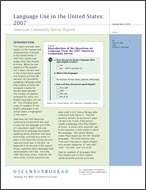Language Use in the United States: 2007
Language Use in the United States: 2007
Introduction
This report provides information on the number and characteristics of people in the United States in 2007 who spoke a language other than English at home. While the vast majority of the population 5 years old and over in the United States spoke only English at home (80 percent), the population speaking a language other than English at home has increased steadily for the last three decades. The number of speakers increased for many non-English languages, but not all. This changing landscape of speakers of non-English languages in the United States is highlighted in this report.
Data from the 2007 American Community Survey (ACS) are used to describe the language use of the U.S. population aged 5 and over. Responses to language and English-speaking ability questions that were historically collected once every 10 years in the decennial census are now captured every year in the ACS. As Appendix A (at the end of this report) shows, questions about language have varied greatly over time. Since the 1980 decennial census, however, the same series of three questions has been used in U.S. Census Bureau data collections (see Figure 1). The first question pertains to everyone 5 years old and over. It asks if the person speaks a language other than English at home. A person who responds “yes” to this question is then asked to report the language. The Census Bureau codes these responses into 381 detailed languages. The third question asks “how well” that person speaks English, with answer categories of “very well,” “well,” “not well,” and “not at all.”
Data on speakers of languages other than English and on their English-speaking ability provide more than just an interesting portrait of a changing nation. Routinely, these data are used in a wide variety of legislative, policy, and research applications. Legal, financial, and marketing decisions regarding language-based issues all rely on information that begins with data on non-English language use and English-speaking ability.1
Table 1 provides some basic information from the 2007 ACS about speakers of non-English languages and their English-speaking ability. Of 281.0 million people aged 5 and over, 55.4 million people (20 percent of this population) spoke a language other than English at home. While the Census Bureau codes 381 detailed languages, data tabulations are not generally available for all of these detailed groups. Instead, the Census Bureau collapses languages into smaller sets of “language groups.” The simplest collapse uses four major groups: Spanish; Other Indo-European languages; Asian and Pacific Island languages; and All Other languages. These four groups are further explained in the text box.
Of the 55.4 million people who spoke a language other than English at home, 62 percent spoke Spanish (34.5 million speakers), 19 percent spoke an Other Indo-European language (10.3 million speakers), 15 percent spoke an Asian and Pacific Island language (8.3 million speakers), and 4 percent spoke an Other language (2.3 million speakers). The majority of speakers across all four of these major language groups reported speaking English “very well.” The percentage of these groups reporting an English-speaking ability of “very well” ranged from around 50 percent of Asian and Pacific Island language speakers to 70 percent of speakers in the Other language group.
People speaking at a level below the “very well” category are thought to need English assistance in some situations.2 Around 24.5 million people reported their English-speaking ability as something below “very well” (that is, “well,” “not well,” or “not at all”). Higher percentages of people needing English assistance were present for speakers of Spanish (47 percent) and Asian and Pacific Island languages (49 percent) than among Other Indo-European languages (33 percent) or Other languages (30 percent).
__________
1 Self-reported data on English-speaking ability have demonstrated the measure to be highly reliable and usable. See “How Good Is How Well? An Examination of the Census English-Speaking Ability Question,” <www.census.gov/topics/population/language-use.html>.
2 For example, the Voting Rights Act of 1965 uses these criteria to determine the need for bilingual election materials.
Appendix Tables
Others in Series
Publication
Publication
Publication





